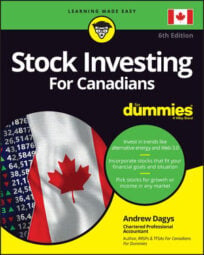Staying up to date on market conditions ensures you’ll know when it’s best to buy or sell.
The ten most important points about stock investing in Canada
Stock investing is a great way for Canadians to build wealth, but it can have its pitfalls. This list spells out the essentials every stock investor should remember.
-
You’re not buying a stock; you’re buying a company.
-
The primary reason you invest in a stock is because the company is making a profit.
-
If you buy a stock when the company isn’t making a profit, you’re not investing — you’re speculating.
-
A stock (or stocks in general) should never represent 100 percent of your assets.
-
In some cases (such as a severe bear market), stocks aren’t a good investment at all.
-
A stock’s price is dependent on the company, which in turn is dependent on its environment, which includes its customer base, its industry, the general economy, and the political climate.
-
Your common sense and logic can be just as important in choosing a good stock as the advice of any investment expert.
-
Always have well-reasoned answers to questions such as “Why are you investing in stocks?” and “Why are you investing in a particular stock?”
-
If you have no idea about the prospects of a company (and sometimes even if you think you do), always use stop-loss orders.
-
Even if your philosophy is to buy and hold for the long term, continue to monitor your stocks and consider selling them if they’re not appreciating or if general economic conditions have changed.
Mandatory reading list for Canadian stock investors
With so much information on newsstands and in your local library, it’s hard to know what are the best sources for stock investing information in Canada. This handy list tells you the five top resources you should consult as a stock investor:
-
The company’s annual report, including its financial statements
-
The reports that the company files with Canadian and U.S. securities regulators
-
Investor’s Digest of Canada
-
Investor’s Business Daily
-
The Globe and Mail and National Post
Top ten websites for Canadian stock investors
The web is full of sites promising great stock investing information, but who can you trust? Here are ten sites that offer Canadian stock investors reliable, trustworthy stock investing news and commentary.
Company data every stock investor should examine
Before you invest in a company’s stock, get a hold of its annual report and search out the following information. This data will let you know if a company’s stock is worth investing in.
-
Cash flow: The company should be a cash generator.
-
Debt: The number should be lower than, or about the same as, the previous year’s.
-
Earnings: The bottom line should be higher than the previous year’s.
-
Equity: The number should be higher than the previous year’s.
-
Sales: This top-line number should be higher than the previous year’s.
The best financial measures for stock investing
Financial ratios help investors find stocks that offer good value by giving numbers meaning and putting them into perspective. If you’re considering investing in a company’s stock, ensure that the company passes these ratio tests.
-
Price-to-earnings (P/E) ratio: For large-cap stocks, the ratio should be under 20. For all stocks (including growth, small-cap, and speculative issues), it shouldn’t exceed 40.
-
Price-to-sales (P/S) ratio: This ratio should be as close to 1 as possible (or below 1).
-
Return on equity (ROE): The ROE should be going up by at least 10 percent.
-
Earnings growth: Earnings should be at least 10 percent higher than in the year before. This rate should be maintained over several years.
-
Debt-to-asset ratio: Debt should be 30 percent or less compared to assets.

